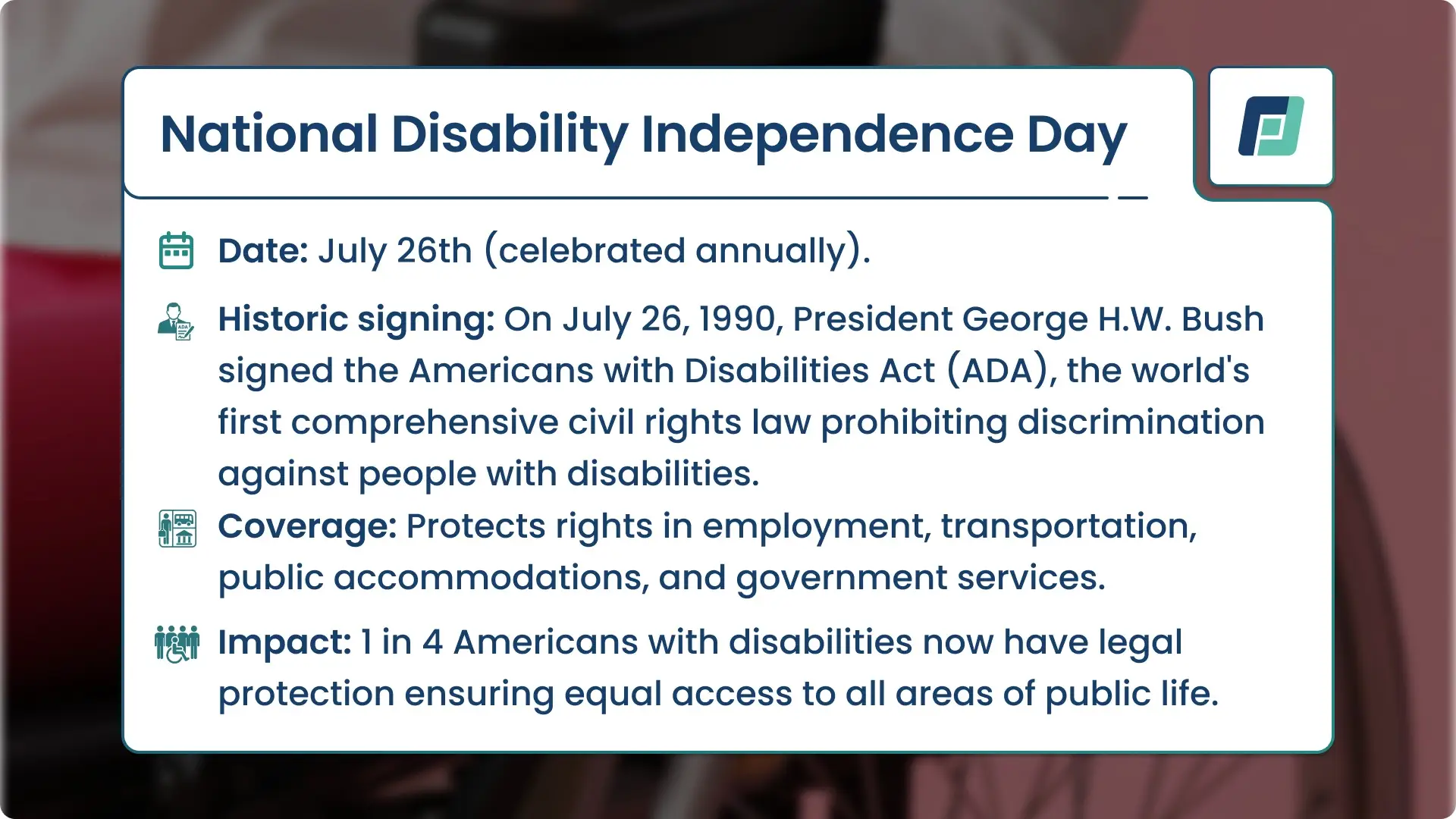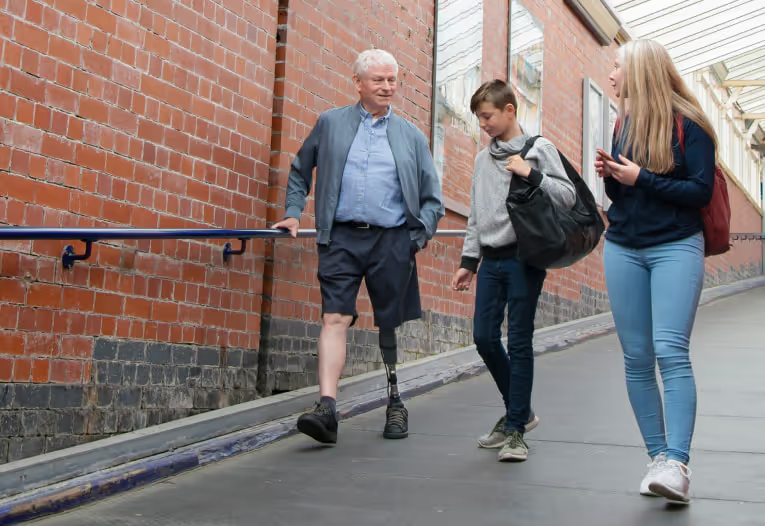Every July 26th, our nation pauses to honor a pivotal moment in American history — the signing of the Americans with Disabilities Act.
At PrimeCare, we're proud to be part of this ongoing journey toward equality and accessibility. As providers of custom upper-limb and lower-limb prosthetics throughout New Mexico and beyond, we witness daily how proper technical assistance and adaptive technology transform lives. As a result, those with disabilities can achieve economic self-sufficiency and engage fully in civic life.
This year’s National Disability Independence Day marks 35 years since President George H.W. Bush signed this landmark legislation, forever changing how our society embraces inclusion and celebrates the contributions of the disabled community.
What Makes National Disability Independence Day So Significant?

National Disability Independence Day is far more than a date on the calendar — it's a powerful symbol of the American disability movement's triumph over centuries of exclusion. Celebrated annually on July 26th, this observance commemorates the moment when discrimination against people with disabilities became illegal under federal law.
There’s even more to this day’s significance; it acknowledges the broader civil rights struggles that paved the way for change and the ongoing efforts to ensure full access to employment, education, and public life for all Americans.

The Americans with Disabilities Act covers the following areas: public accommodation, employment, transportation, and state and local government services. This comprehensive coverage means that whether someone is visually impaired, uses a wheelchair, or faces any other disability, they have legal protections ensuring their right to participate in society. The law touches every aspect of daily life, from accessing public establishments to securing fair treatment in the workplace.
This protection extends to all individuals, whether they use athletic prosthetics for sports participation, require specialized finger prosthetics for fine motor tasks, or need pediatric prosthetics designed for growing children. The law ensures that prosthetic technology must be accommodated in all public spaces.
The Journey to July 26: A Historical Perspective

The path to disability independence didn't begin with the ADA — it grew from decades of advocacy and determination by the disability community. This movement gained momentum during the 1960s, challenging long-held prejudices that relegated disabled people to society’s margins.
Several landmark moments made up the evolution toward equal rights:
- The passage of Section 504 of the Rehabilitation Act of 1973 was a major step for the betterment of people with disabilities. This section prohibited recipients of federal funds from discriminating against people with disabilities, laying the groundwork for future protections in healthcare, including access to prosthetics covered by insurance.
- The Barden-LaFollette Act expanded vocational rehabilitation services to include blind and mentally disabled individuals, broadening the scope of who could receive support.
- Section 508 of the Rehabilitation Act, updated in 1998 and again in 2017, mandated that federal digital information be accessible to those with disabilities.
- The ADA was first introduced in 1988, designed to build on the progress of the Rehabilitation Act and expand the rights of the disabled community into a single law to ensure their freedom from discrimination in employment, transportation, communication, and government and public establishments.
When President George H.W. Bush signed the ADA on July 26, 1990, he stood before more than 3,000 attendees, many with disabilities, alongside disability rights activists and advocates. It was a powerful moment, to say the least.
"Three weeks ago, we celebrated our nation's Independence Day, and today we're here to rejoice in and celebrate another Independence Day, one that is long overdue," he declared. His words captured the monumental nature of this achievement, recognizing it as a second Independence Day for millions of Americans.
How to Honor and Celebrate This Important Day
Celebrating National Disability Independence Day goes beyond mere recognition — it's about taking concrete actions that advance equality and accessibility in our communities. Organizations and individuals nationwide find meaningful ways to mark this occasion while promoting awareness and inclusion. If you want to get involved, here’s what we recommend.
Educational Initiatives and Awareness Campaigns
Communities nationwide host workshops and seminars focusing on disability rights, the history of the ADA, and current challenges the disability community faces. These events often feature speakers who share personal stories about overcoming barriers and achieving independent living.
Many speakers include inspiring amputee celebrities and everyday heroes who demonstrate what's possible with determination and proper support. Schools incorporate lessons about the disability rights movement, helping young people recognize how this law transformed American society. For parents of children with limb differences, these educational opportunities provide valuable insights into helping kids adjust to prosthetics and helping them fully participate in school activities.
Supporting Local Disability Organizations

Want to get involved in the community? Many choose to volunteer with or donate to organizations that provide technical assistance and resources to people with disabilities. These groups work tirelessly to ensure individuals have the tools and support needed for full participation in employment, education, and community activities. Supporting these organizations strengthens the infrastructure that makes independence possible.
Advocating for Continued Progress
While the ADA established crucial protections, the work toward true equality is ongoing. The unemployment rate for people with a disability was 7.2 percent in 2023, while the rate for those without a disability remained unchanged throughout the year, at 3.5 percent, highlighting ongoing disparities. Advocacy efforts focus on closing these gaps through improved workplace accessibility, better public accommodation standards, and enhanced support systems.
While the ADA established crucial protections, real-world barriers persist. Many individuals still face questions about disability benefits eligibility, for example.
Creating Inclusive Spaces
Businesses and organizations can honor this day by evaluating and improving accessibility features. This includes ensuring physical modifications and digital content meet accessibility standards and providing communication options for various needs. Staff should also be trained on disability etiquette and inclusion practices.
Moving Forward Together: The Future of Disability Rights
As we commemorate National Disability Independence Day 2026, we recognize both the tremendous progress achieved and the work that remains. Did you know that today, one in four Americans with a disability can access and participate better in their workplaces and general communities? Despite this reality, achieving true equality requires ongoing commitment from all sectors of society — government, businesses, educational institutions, and individuals alike.
At PrimeCare, we're honored to play a role in this continuing journey toward full inclusion. Through our custom prosthetic solutions and sheer passion for helping this community, we help individuals overcome physical barriers and embrace opportunities in employment, education, and all aspects of public life. Contact us to learn how we can support your path to greater independence!

.svg)
.svg)









